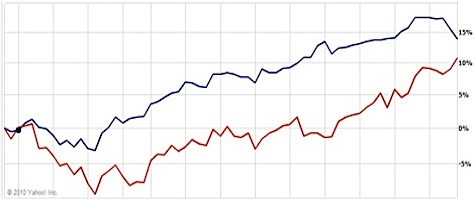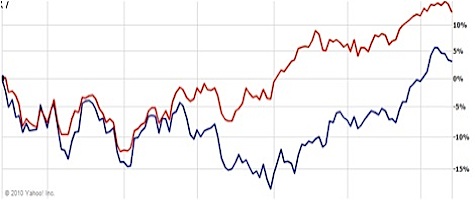Looking to play the technology sector through ETFs? Let’s cut to the chase right away: The technology sector is HUGE and because of that, there are a multitude of ETFs available. Some investors choose ETFs because they don’t want to have to pick individual stocks. While there are broad technology sector ETFs, it is best to have some sector specific exposure ETFs in your portfolio as well.
Let’s take a look at what a Technology ETF portfolio may look like. Of course, it is not recommended that your portfolio be made up of only technology ETFs but if you are looking to put together a technology ETF basket, here are some ways to do so.
Broad Market Technology ETF: Technology SPDR (XLK)
No ETF basket is complete without a Spider. A Spider is the money management term for an offering of broad sector ETFs formally called Select SPDRs. There is a Spider for each of the broad sectors, and for our technology basket, we’re going to start with the Technology Spider, XLK.
There is another use for the Spiders that may be even more useful than owning the actual ETF. The Spiders are great for comparison purposes. Let’s say that you were considering buying some shares of Intel. To see how Intel has performed in relation to the broader technology sector, make a chart that compares the two:

In this chart, the red line is the performance of Intel and the blue line is the XLK or the broader index. First we see that Intel has underperformed the broader sector but it’s also important to note that in the near term (the far right), Intel has continued to see buying interest while the XLK has begun to trend down. This may be worth some investigation.
There’s another purpose for the XLK. Hedging. Some investors, in an effort to hold some downside protection, may purchase an individual stock while shorting the sector ETF. (We’ll save that strategy for another article).
It would be difficult to see a reason why the XLK shouldn’t be included in our ETF basket, although depending on when you’re reading this, market conditions may have changed — so make sure to do your own research.
ProShares UltraShort Technology (REW): A Short ETF
Any basket of stocks or ETFs must be constructed and managed with market conditions in mind. Every investor has an opinion of where the market is going and if you believe the market is trending down, consider the short term addition of the REW.
REW is a leveraged ETF that moves 2X the amount of the inverse direction of the broad technology sector. Here’s an example: Let’s assume that the technology sector drops 1% today. REW will move twice as much in the opposite direction so when the tech sector drops 1%, the REW will rise 2%. There will be rebalancing and management fees so the movement won’t be exactly 2%. More on leveraged ETF investing here.
This may be a position that may be good to trade based on market conditions. Also, remember that this is a leveraged ETF, so when you’re thinking about what percentage of your basket will hold this short position, you have to multiply it by 2. As an example, if you see a short term pullback coming and you want a 20% weighting for your short position, you only need to commit 10% of your basket’s funds due to the leveraged nature of this ETF.
Sub Sector ETFs
The last part of our technology ETF basket is a series of sub sector ETFs. Within the larger technology sector, there are a series of subsectors. These include software, hardware, networking, semiconductors, technology services, and nanotechnology, to name a few.
How many of these do you need? As with any portfolio, it’s important to diversify and balance the holdings. Different managers will give you different opinions, but if your technology basket had a total value of $10,000, then you may want to devote $5,000 to these subsectors. Note, however, that you shouldn’t commit money to all of these sub sectors. If you’re thinking about putting a little bit of money into each of these sub sectors, you might as well just invest more in the broader market ETFs (which is a similar diversification strategy). So let’s look at things a little differently.
Treat these sub sectors like individual companies. Keep a close eye on the charts and see which are obviously in favor right now. Take a look at the chart below:

In this chart, the red line is the iShares S&P GSTI Software Index Fund (IGV) which is a software subsector ETF. The blue line is the semiconductor Spider (XSD). As you can see, for quite a while, both sectors moved together; but later, the semiconductor Spider went out of favor and has underperformed the software sector considerably. These are the types of trends you should watch for as you trade these sub sectors over time.
Anything Else?
We should speak briefly about the behavior of the sector. One of those investing “rules of thumb” states that 50% of a stock’s movement is tied to its sector. The technology sector is rather big and vast such that these correlations exist more in the sub sectors instead of the broad tech sector. For this reason, don’t conclude that the technology sector ETFs are interrelated. Look for those correlations in the subsectors.
Good luck with investing here!
Copyright © 2010 The Digerati Life. All Rights Reserved.

{ 2 comments… read them below or add one }
Great! I didn’t know some people (investors) could use XLK. Hedging to get some downside protection, and purchase individuals stocks while shorting the sector ETF.
Very much informative post. I like it. Thanks for sharing in the web.